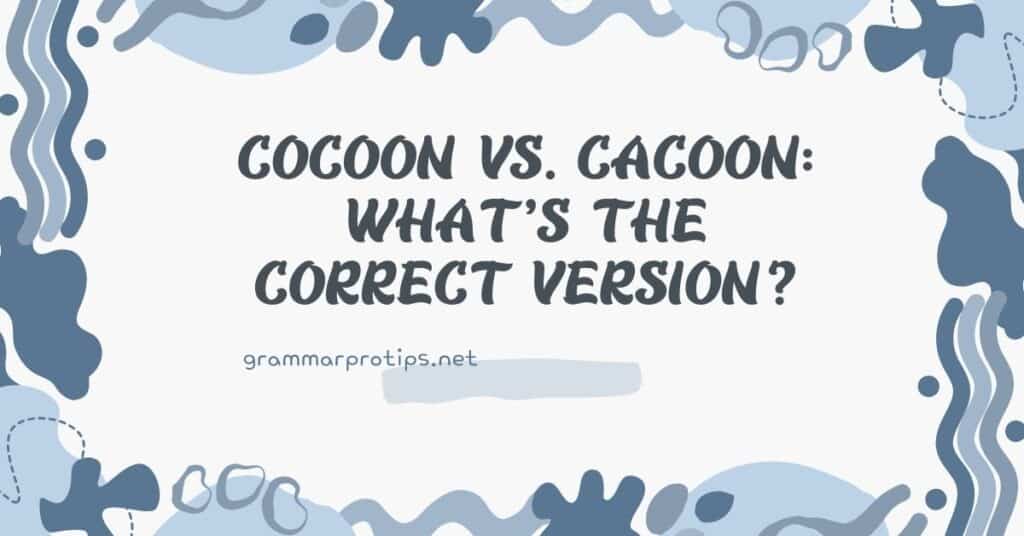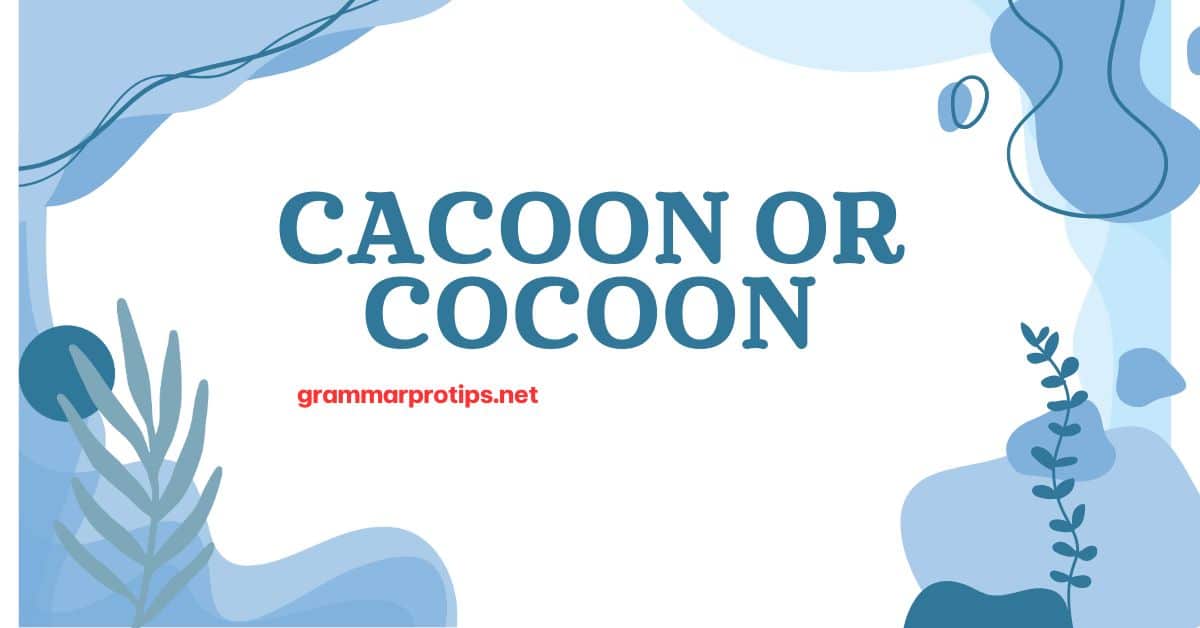When you’re writing, it’s easy to fall into the trap of mistyping a word, especially when it’s something as deceptively simple as “cocoon.” But here’s the thing: Is it “cacoon” or “cocoon”? You might find yourself questioning whether the double “c” or the extra “a” is the right choice.
In this article, we’ll dive deep into the origins of these words, explore their correct spelling, and even provide helpful examples to make sure you spell cocoon correctly every time.
What is a Cocoon?
Let’s start with the basics. A cocoon is a protective covering spun by certain insects, like moths and butterflies, during their pupal stage. It’s a part of their natural life cycle, where they are undergoing transformation. In simple terms, a cocoon is the shell that protects an insect while it morphs into its adult form. Think of it as the insect’s version of a cozy blanket.
The word “cocoon” itself comes from the French word “cocon,” which means “little shell.” Over time, this evolved into the English word we recognize today.
But what about “cacoon”? Could that be a valid alternative spelling? Let’s explore this further.
The Case for “Cacoon” (or Is There One?)
You may have seen “cacoon” pop up here and there, especially when someone is unsure of how to spell cocoon. The truth is, “cacoon” is a common misspelling of “cocoon.” There’s no valid reason to use “cacoon” unless you’re simply typing it incorrectly.
For example, if you were writing an email to a friend and said:
“I just found a cacoon in my garden. It’s so fascinating!”
That would be a classic error. The correct spelling should be “cocoon.”
So, if you’re wondering “how do you spell cocoon?”, the answer is simple: cocoon.
Let’s explore a real-world scenario to drive this point home.
Scenario 1: Email Mistake – “Cacoon”
Imagine you’re emailing a colleague about a recent gardening project. You want to sound informed, but the spellcheck doesn’t catch your error:
Subject: “Garden Discovery!”
Email Body:
Hey Mark,
I was checking on my plants today and discovered something cool! I found a cacoon hanging from one of the branches. It looks like a moth is going to emerge soon. Let’s catch up later this week to talk about the next steps for the garden project.
Best,
Emma
In this case, Emma has made a small but noticeable spelling error. “Cacoon” should be replaced with “cocoon.”
Why the Confusion?
The confusion between “cacoon” and “cocoon” often arises because the word sounds like it could be spelled with an “a.” It’s easy to think that “cacoon” is the right choice, but as we discussed earlier, “cocoon” is the only correct spelling.
Cocoon vs. Cacoon: What’s the Correct Version?

When you see “cacoon or cocoon” written, it’s likely that the writer is unsure about which spelling is correct. To clarify, cocoon is the definitive spelling in the English language. There is no place for “cacoon” in any standard English dictionary.
To further explain this, here’s a simple breakdown:
| Spelling | Correctness | Definition |
|---|---|---|
| Cocoon | Correct | A protective covering spun by certain insects during their pupal stage. |
| Cacoon | Incorrect | A common misspelling of “cocoon.” Not recognized as a valid English word. |
When you’re questioning “how do you spell cocoon,” just remember, it’s always cocoon.
Common Mistakes and How to Avoid Them
You’re not alone if you’ve typed “cacoon” by mistake. Here are a few common scenarios where people confuse these two spellings:
- Typing Quickly: It’s easy to type “cacoon” when you’re in a hurry, especially if your fingers stray to the “a” instead of the “o” key.
- Mishearing the Word: Since “cocoon” sounds like it could be spelled with an “a,” you might mistakenly spell cocoon as “cacoon.”
- Autocorrect Errors: Sometimes, autocorrect tools can mess things up, especially if you’re typing on a phone or tablet. While these tools are generally helpful, they might not always catch the difference between these two spellings.
Scenario 2: Social Media Post – “Cacoon”
Now, let’s say you’re posting a picture of your garden on social media, and you want to share your excitement about the insect activity.
Post Caption:
“Spotted a beautiful cacoon on one of my bushes today! Can’t wait to see what comes out of it.”
Again, the misspelling creeps in, and this time it’s for a public audience. This could lead to confusion or, worse, the appearance that you don’t know your insect terminology. Stick to “cocoon” for better clarity.
Why It’s Important to Get It Right
Using the correct spelling, especially when it’s a common word like “cocoon,” not only boosts your credibility but also ensures you’re understood clearly. While a typo here and there is inevitable, spelling errors like “cacoon” might cause readers to wonder whether you’re fully informed about your topic. It may even cause a bit of amusement or distraction if it’s noticed.
For example, here’s a simple exchange:
Friend 1:
“Did you see that cool cacoon in my yard?”
Friend 2:
“Wait, a what? I think you meant cocoon.”
By sticking to cocoon in all your communications, you ensure your message is both accurate and professional.
Fun Facts About Cocoons
If you want to impress your friends or colleagues with your knowledge, here are a few fun facts about cocoons that will make your conversation even more interesting:
- Not All Cocoons Are the Same: Not every insect forms a cocoon. For example, butterflies create chrysalises (similar to cocoons) during their transformation, but moths spin true cocoons.
- Some Insects Use Silk: Many insects, including moths and caterpillars, use silk to spin their cocoons. This silk is produced by glands in their bodies and is used as a protective layer.
- Cocoon Color: Depending on the species, cocoons can come in various colors like white, brown, or even green. Some cocoons are incredibly tough, while others are soft and fragile.
Summary: Cacoon or Cocoon?
To sum up, “cocoon” is the correct spelling. While “cacoon” might be a common error, it doesn’t hold any real meaning or validity in the English language. So, whether you’re writing an email, posting on social media, or simply engaging in conversation, you’ll want to stick with cocoon.
To avoid confusion in your writing, make sure you double-check your spelling, especially with words that look deceptively similar. By doing so, you’ll keep your communication clear, polished, and professional.

Sienna Mauldon is a passionate writer and grammar expert. On her blog, she shares easy-to-follow guides to help readers master grammar rules and improve their writing. With a love for language and teaching, Sienna makes grammar simple and fun for everyone, from beginners to experienced writers.








